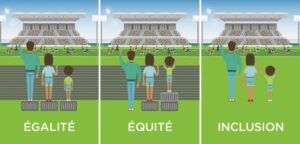EQUITY, DIVERSITY, INCLUSION…. VOCABULARY ITEMS

Equity is synonymous with justice, meaning that people, regardless of their identity, are treated fairly. This means ensuring that resource allocation and decision-making mechanisms are fair to all and do not discriminate based on identity. Measures must be adopted to end the discrimination and inequalities that have been reported and documented and to guarantee, as far as possible, equal opportunities.
Indeed, equity is necessary to achieve equality. For example, it may be inequitable to treat people as equals in a context where the system has long disadvantaged some people so that those people could not function as equals. This lacks the justice inherent in a truly equitable situation.
Equity strategies are different from equality strategies. To differentiate these two types of strategies, the following statement is used: “Equity is a means, equality is a goal ”. In other words, it is not a matter of providing exactly the same treatment to each individual, but rather of adapting the strategies according to specific needs to achieve equality.
Diversity refers to the conditions, modes of expression and experiences of different groups defined by age, education, sexual orientation, parental status or responsibilities, immigration status, religion, disability status, language, ‘race’, place of origin, ethnic origin, culture, socio-economic status and other attributes.
Diversity also refers to gender identity or gender expression.
Inclusion refers to creating an environment where all people are respected equally and have access to the same opportunities. At the organizational level, inclusion requires the identification and removal of barriers (physical or procedural, visible or invisible, intentional or unintentional) that impede people’s participation and contribution. It also requires affirming the values and principles of equity, fairness and respect by being open to different opinions and perspectives, developing an understanding of other cultures, experiences and communities, and making a conscious effort to be welcoming, helpful and respectful to all.
Extracts from the wiki page Équité, diversité, inclusion (Université du Québec à Montréal).
A more complete definition of these terms can be found on the page Autres termes de référence.


